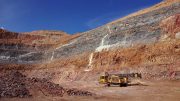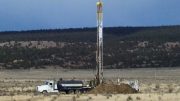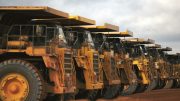The U.S. is fertile ground for a variety of minerals, and Canadian companies are active throughout the country. The Northern Miner presents its top 10 list of the biggest Canada-based firms with substantial assets in the U.S., by market capitalization, as of July 24.
1. Barrick Gold
Market cap: US$50 billion

Barrick Gold’s Cortez pit, looking north. Credit: Barrick Gold.
Toronto-based Barrick Gold (TSX: ABX; NYSE: GOLD) has projects in 13 countries around the world. But the company’s U.S. operations have been crucial in maintaining its leading position on the list, especially its operations in Nevada.
In 2019, the company joined forces with Newmont (TSX: NGT; NYSE: NEM) to create Nevada Gold Mines (NGM). NGM oversees the world’s largest gold mining complex, with assets that include 10 underground mines and 12 open pit mines, three of which are considered ‘tier-1’. Additional assets are two roaster facilities, two autoclave facilities, two flotation facilities and four oxide mills.
Barrick operates NGM and owns 61.5% of the company, with Newmont holding the remaining ownership. At the beginning of July, Barrick announced that NGM had exceeded all expectations a year into the joint venture.
The company says NGM’s exceptional performance is all the more noteworthy as it first required the integration of multiple assets from both companies into a unified complex, and then has had to weather the workplace safety protocols created by the Covid-19 pandemic.
In 2019, Barrick’s share of NGM’s total output of gold amounted to 572,000 ounces. However, in just the first quarter of 2020, NGM produced 855,000 oz. gold, of which Barrick’s share was 526,000 ounces. The second quarter added an additional 521,000 oz. gold from the mine complex, and the company predicts that NGM’s production output for all of 2020 will amount to between 2.1-2.25 million oz. gold.
2. Kinross Gold
Market cap: US$10.4 billion

Kinross Gold’s Round Mountain gold mine in Nye County, Nevada. Credit: Kinross Gold.
Kinross Gold (TSX: K; NYSE: KGC) is another Canadian miner focused on American properties to bolster its bottom line. While its portfolio includes mines in Brazil, West Africa and Russia, it is Kinross’ U.S. operations that made up the majority of the company’s gold equivalent production last year.
The company’s wholly-owned open pit mines are located in Alaska and Nevada. The northernmost operation, Fort Knox, is located near the city of Fairbanks, and is one of the few cold weather heap leach facilities in the world. In 2019, the site poured its 8 millionth ounce of gold, and last year’s overall production was 200,263 oz. gold-equivalent. While it had been nearing the end of its mine life, Kinross continues to develop the adjacent Gilmore expansion project, which would extend operations at the site until 2030. The company says the project is progressing on schedule and on budget, and remains on target for completion in the second quarter of 2020.
In Nevada, Kinross has two operational, open pit mines. Round Mountain, located in the south-central part of the state, produced 361,664 oz. gold-equivalent in 2019, down slightly from the year before. Round Mountains’ estimated mine life extends to 2024, with stockpile milling and residual leaching continuing operations until 2027.
The company’s other Nevada property, Bald Mountain is the largest private mining land package in the U.S., located along the southern extension of the prolific Carlin Trend about 110 km from the city of Elko. The open pit, heap leach operation’s 2019 production was 187,961 GEOs.
3. Teck Resources
Market cap: US$6 billion

Teck Resources’ Red Dog high-grade zinc mine in Alaska. Credit: Teck Resources
The key to Teck Resources’ (TSX: TECK.A and TECK.B; NYSE: TECK) U.S. presence is its zinc mine in northwestern Alaska. The Red Dog operation, located 180 km above the Arctic Circle in a remote part of the state, is one of the reasons Teck is the world’s third-largest producer of mined zinc.
The sprawling operation is located 85 km inland from the Chukchi Sea that separates Alaska from Siberia. It has been producing since late 1989, and is expected to remain in production until 2031. Red Dog produced 553,000 tonnes zinc, contained in concentrate, in 2019. The Vancouver-based company says gross profits from the mine amounted to US$696 million last year.
Concentrates from Red Dog are shipped south to Teck’s metallurgical facilities in Trail, B.C., and to customers in Asia and Europe. In early July, Teck reported a failure of the loading arm on a barge at the Red Dog transshipment port on the Chuchki Sea, west of the mine. There were no injuries or environmental impacts related to the mechanical incident. While the company foresees some delays in customer deliveries, management expects to move all of Red Dog’s production during the 2020 shipping season, barring unforeseen severe weather.
Teck’s other U.S. operation, the Pend Oreille zinc mine in the far northeastern corner of Washington state, closed at the end of July 2019. At the time, Teck blamed a slowing demand for refined metals and a surplus of unrefined ore in the market.
4. Lundin Mining
Market cap: US$4.3 billion

Lundin Mining’s 80%-owned Candelaria copper-gold-silver mine in Chile. Last October Franco-Nevada agreed to purchase gold and silver streams from the mine for US$648 million. Credit: Lundin Mining
Like Teck, Toronto-based Lundin Mining (TSX: LUN) has only a single U.S. operational asset, but its wholly owned Eagle mine has proven a consistent performer in a portfolio that includes operations in Sweden, Portugal, Brazil and Chile.
Operated by Lundin’s subsidiary Eagle Mine, the site is located in Michigan’s Upper Peninsula, northwest of the city of Marquette, about 20 km south of Lake Superior. It is the only primary nickel mine in the U.S., and Lundin expects it to produce 360 million lb. nickel over its mine life, which extends to 2025. An additional 295 million lb. copper are also estimated to be extracted over the same period.
The mine’s output is approximately 2,000 tonnes per day. For 2019, Lundin says that Eagle met its yearly guidance, producing 13,494 tonnes of nickel and 14,297 tonnes of copper. In the first quarter of this year, output totalled 3,575 tonnes of nickel and 4,378 tonnes of copper.
Nickel production was lower than in 2019 due to reduced grades and recoveries partially offset by increased mill throughput. Copper production was higher than the comparable period in the prior year due to increased throughput. Lundin’s overall production guidance for the Eagle mine in 2020 is 15-18,000 tonnes each of nickel and copper.
5. NovaGold Resources
Market cap: US$2.9 billion

An undated photo of the camp at NovaGold Resources’ Donlin Gold project in Alaska, now a joint venture with Barrick Gold. Credit: NovaGold Resources.
After months of inactivity caused by the Covid-19 pandemic, NovaGold Resources (TSX, NYSE-AM: NG) announced at the end of June that drilling had resumed at its flagship U.S. asset, the Donlin Gold property in southwestern Alaska. Vancouver-based NovaGold is an equal co-owner of Donlin with Barrick Gold. The proposed mine’s proven reserves are 573,000 oz. gold with probable reserves at 33.28 million ounces.
The field program at the Donlin site has four drill rigs turning. NovaGold anticipates that most of the planned program, aimed at confirming geologic modelling concepts and testing potential extensions of high-grade zones, will be completed by the end of the year. This will entail drilling about 80 holes totalling 22,000 meters.
Based on exploration work, Donlin is envisioned as an open pit mine, processing 59,000 short tonnes of ore per day. Annual production is estimated at 1.1 million oz. gold, with a life span of 27 years. This would make Donlin one of the world’s largest gold mines.
NovaGold’s financial results for the second quarter of 2020 show the company has maintained a strong treasury, with US$134.3 million in cash and term deposits as of May 31. The company anticipates spending US$31 million on the project this year, with the majority earmarked for the drill program.
6. SSR Mining
Market cap: US$2.9 billion

Pit operations at SSR Mining’s Marigold gold mine in Nevada. Credit: SSR Mining.
SSR Mining (TSX: SSRM; NASDAQ: SSRM) saw gold production increase at its Marigold mine in northern Nevada in 2019. According to the company, Marigold’s output last year was 220,227 oz. gold, a record that was almost 15,000 oz. higher than the year before. At the end of June, the mine produced its 4 millionth ounce of gold. SSR estimates 2020 production at between 225,000 and 240,000 ounces.
The mine has been in continuous operation since 1989, and SSR completed its acquisition of the property in 2014. An updated life of mine plan for Marigold forecast peak production of over 265,000 oz. gold in 2021 and 2022.
This year, the company intends to spend approximately US$14 million on exploration, with the goal of extending the mine’s life. The exploration program will focus on reverse circulation drilling in search of near-surface mineral resources, and diamond drilling targeting high-grade sulphides.
In July, SSR announced that shareholders had overwhelmingly approved a no-premium deal to merge the company with Denver-based Alacer Gold (TSX: ASR). Alacer operates the Çöpler gold mine in eastern Turkey. The merger, proposed in May, would eventually see the two companies operate under the SSR Mining name and be headquartered in Denver with a corporate office in Vancouver.
7. Equinox Gold
Market cap: US$2.7 billion

Pit operations at Equinox Gold’s Mesquite gold mine in California. Credit: Equinox Gold.
In March of this year, Equinox Gold (TSXV: EQX; NYSE-AM: EQX) completed its merger with rival mid-tier gold producer Leagold Mining. The US$578 million acquisition of Leagold transformed Equinox into a company with six producing gold mines, two growth projects and two expansion projects. The takeover is another element in Equinox’s objective to become a million-ounce gold producer.
Equinox’s key U.S. asset is its Mesquite mine in southern California, 250 km east of San Diego. The open-pit heap leach mine is one of the largest gold mines in the U.S., and was acquired by Equinox in October, 2018. In 2019, it produced 125,736 oz. gold, at an all-in sustaining cost (AISCs) of US$933 per ounce. The company expects the mine to produce 120-130,000 oz. gold this year at AISCs of US$975-1,025 per ounce.
As Mesquite’s remaining mine life is only two to three years (plus residual leaching), Equinox has been engaged in a development program at a second site in California. Castle Mountain is situated 320 km north of Mesquite near the Nevada state line, and the company believes it has the potential to produce up to 200,000 oz. per year. Phase 1 construction commenced in 2019 and is now 75% complete, and the company expects the first gold to be poured there in the third quarter of this year.
8. Hudbay Minerals
Market cap: US$878 million

Trucks at Hudbay Minerals’ Rosemont copper project in Arizona. Credit: Hudbay Minerals.
Toronto-based Hudbay Minerals (TSX: HBM; NYSE: HBM) has been working to develop two primary copper projects in the U.S. — Rosemont in Arizona and Mason in Nevada. Rosemont, located just southeast of Tucson, has long been planned by Hudbay as its flagship U.S. asset, and is expected to be one of the largest copper mines in the country.
The proposed open pit mine’s annual production is estimated at 127,000 tonnes in the first ten years of operation. The company says the property’s proven and probable mineral reserves are 537.1 million tonnes grading 0.45% copper.
Rosemont had been expected to begin production in 2022, and construction was already underway when a July 2019 U.S. District Court judgment halted work on the project. That judgment revoked the U.S. Forest Service’s issuance of the final record of decision for Rosemont. In late June, the company announced it was appealing the court decision, though a final decision in the appeal process is not likely to occur until late 2021.
Meanwhile, the company continues to look at developing its Mason property, located southeast of Reno, Nevada. Hudbay conducted strategic land consolidation near the Mason project, including a large package of claims hosting potential for high-grade skarn deposits. The company says the measured and indicated mineral resource for the property amounts to 1.4 billion tonnes grading 0.32% copper.
9. McEwen Mining
Market cap: US$525 million

McEwen Mining’s Gold bar gold project in central Nevada. Credit: McEwen Mining.
McEwen Mining (TSX: MUX; NYSE: MUX) has precious metals projects spread across both North and South America, with its key U.S. production asset being the Gold Bar open pit mine in north-central Nevada. It is located 40 km southeast of the Nevada gold mine project that is jointly owned by Barrick and Newmont.
Production at Gold Bar commenced in May 2019, and by year’s end output totalled 31,712 oz. gold-equivalent. After producing 9,100 oz. gold-equivalent in the first quarter of 2020, operations ceased at the mine on April 1 due to Covid-19 concerns. Production did not resume until May, but Gold Bar still managed to produce 6,100 oz. gold-equivalent in the second quarter.
Toronto-based McEwen says that the Gold Bar mine’s measured and indicated mineral resource estimate totals 30 million tonnes grading 0.92 grams per tonne, for a total of 819,000 contained oz. gold, with a further 7.583 million tonnes inferred, grading 0.91 grams per tonne for 201,000 contained oz. gold.
However, the company says the mine’s life is only 7.4 years, which pushed it to acquire a property 5.5 km southeast of Gold Bar. Known as Gold Bar South, it consists of 109 mining claims and hosts a near-surface oxide gold deposit. An extensive drilling program carried out in 2019 led the company to announce that Gold Bar South’s resource estimate (measured and indicated) is 2.064 million tonnes grading 1.07 grams per tonne for 64,000 contained oz. gold.
10. Premier Gold Mines
Market cap: US$446 million

Premier Gold Mines president and CEO Ewan Downie in front of a portal at its 40%-owned South Arturo gold project in Elko County, Nevada. Credit: Premier Gold Mines.
Premier Gold Mines (TSX: PG) has seen its key U.S. asset, the South Arturo gold project in northern Nevada, move into production in late 2019. The company owns 40% of South Arturo, with the remainder owned by Nevada Gold Mines (a joint venture between Barrick and Newmont). The property is located in the Carlin Trend. Development of the mine focused on two mining centres: the El Niño underground mine and open pit operations.
The El Niño underground mine achieved commercial production in October 2019, more than three months ahead of schedule, and was in full production by the fourth quarter of last year. By the end of the year, El Niño had recovered 5,964 oz. gold (including 562 pre-production oz.) to Premier’s account, with an additional 3,855 contained oz. gold stockpiled for future processing. In the first quarter of 2020, Premier reported gold production from the underground mine totalled 6,730 oz. gold.
In May, Premier announced it had begun its 2020 exploration drill program at the company’s other U.S. property, the wholly owned McCoy-Cove project. Located along the Battle Mountain Trend in Nevada, the company says the property’s indicated resources are 948,000 tonnes grading 11.20 grams per tonne for 342,000 oz. gold. The inferred resources are 3.66 million tonnes grading 11.20 grams per tonne for 1.32 million oz. gold.





Be the first to comment on "Top 10 Canada-based companies with substantial US assets"